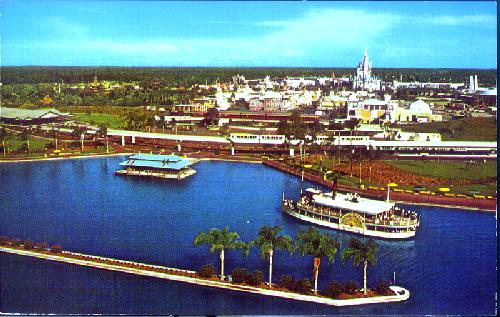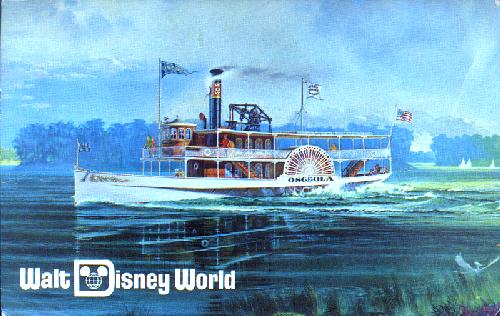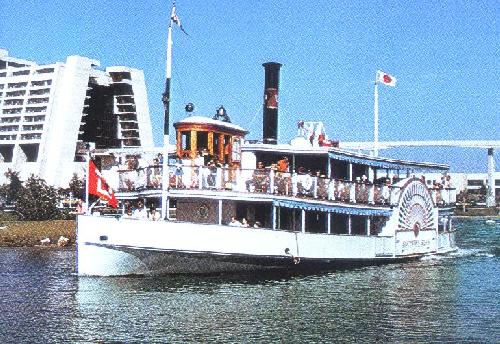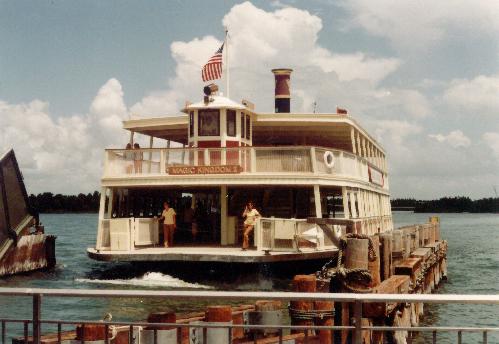A History in Postcards
Sailing the Seven Seas (Lagoon)
Part I Excursion Steamers
A page on the larger craft plying the Waterways of Bay Lake and the Seven Seas Lagoon

This early view of the transportation hub at the entrance to the Magic Kingdom seems most notable to me for the side wheeler steamboat bringing guests to the dock in front of the Magic Kingdom. When I first started this project I thought perhaps these boats were the pre-cursors to the ferryboats, in part because You can't see the Ferry landing in this view. Later I decided that I was wrong, I thought that perhaps the ferry dock would have been out of frame anyway (to the right). It wasn't until 2008 that former watercraft cast member Greg Chin emailed me and let me know that my original thinking was correct, the first two ferrries did not go into service until 1973, and until then the side-wheeler steam ships were used to take guests from the TTC to the Magic Kingdom, Greg Wrote:
Your Postcard image of the Osceola-class Southern Seas arriving at the Magic Kingdom Cruise Dock, showing that the Ferryboat Dock wasn't there, is indeed correct. The postcard shows a pink concrete slab, with the benches and patio umbrellas, on that straight east-west extension of the dock. Later, that was the Ferryboat Dock. It's not out of the photo. It just wasn't built yet, on that straight extension. The Ferryboat Dock's wooden "patio" decking is really about 2' in elevation, above the existing pink concrete slab. The narrower and angled, pink concrete area, was always there for the motor launches and motor cruisers. They probably built the lt. blue canvased ferryboat dock during 1973, when the first two ferryboats were also being built. The third ferryboat, the Kingdom Queen wasn't built until 1975-1976. The MK Tram Drop-off area (under the MK monorail beamway) is still there in the postcard, and wasn't modernized with the covered MK Bus Depot until the late 1980's, (or else 1986-1987) when the Disney resort expansion was beginning. The Grand Floridian Beach Resort, and the two new resort convention centers required that the new MK Bus Depot to be built. I was glad to see the Bus Depot built. We needed it, especially during the Summer nights.
The ship on the card above is one of the Excursion Steamers like the one on the pre-opening postcard below.

There were two of these Excursion Steamers in the early fleet
and unlike the one on the pre-opening card
neither of them was named the Osceola.
They were named the Southern Seas, and the
Ports O' Call. and in the early "pictorial souvenir"
books it was often noted that they "have
"walking beam" engines unlike any built in 100 years"
Even though in the end none of the steamers ended up being named Osceola
they were called "Osceola Class" Here's Captain Matt with more:
There were actually two side-wheel steamers named the "Southern Seas"
The original "Southern Seas" was retired in 1975 and scrapped in 1977.
The "Ports of Call" was retired in 1982 and scrapped in 1984.
The second "Southern Seas" was built in 1977 after the scrapping of the first.
After the opening of Epcot in the 1980s the boat wasn't used as much.
It was used for midnight cruises, and for trips to and from the World Cruise
dock to Discovery Island. But in 1997, it was deemed unnecessary and was
taken out to a hill behind dry dock and scrapped after 20 years of service."



Also in closer views of these "Excursion Steamers" it
looks like they have a much smaller capacity than the ferryboats.
Still according to one source in
the early days of the park they were so pressed for capacity
in getting people to the park they were for a time pressed into service.
David Koenig writes "Although they
would eventually be used for "pleasure cruises," their initial use,
starting with Opening Day, was to supplement the Monorail as transportation
from the Transportation Center to the Magic Kingdom, until other ships and
Monorail cars could be added."
In reference to the pleasure cruises David mentions
here's a description from one of the park "Information guides"
:
"WORLD CRUISE. Sail the 650-acre Waters of the World
aboard a colorful side wheel steamboat.
Narrated tours describe Walt Disney Worlds history . . .
and preview it's future. adults
$1. Children (3-11), 50¢."
(winter/Spring 1974 information guide compliments of GAF).
In the resort section of
the same guide The Polynesian, Contemporary, and Fort Wilderness
resorts all list under Entertainment:
"Moonlight Cruises aboard colorful side wheel steamers
depart the"Polynesian Village Marina/ Contemporary
Resort Marina/ Fort Wilderness Landing " for a
full evening of fun afloat. Cocktails and
soft drinks are sold on board."
I also have a Summer/ Fall 1974 information guide in which the resort
information on cruises is basically the
same but in which the attraction listing for the World Cruise is limited
to basically being listed as one
of the possible ways to get to "TREASURE ISLAND!".
Treasure Island was the Early name of
Discovery Island and according to Disney A to Z it opened April 8, 1974
and changed its name to Discovery Island in 1977.
A VOYAGE ON THE PORTS O' CALL THROUGH THE EYES OF A LIVE STEAM ENTHUSIAST
I rode the Ports of Call as a little boy in 1979 or 1980. I knew about it in advance and specifically made the effort to plan our schedule. I spent most of the voyage standing at the engine room door, watching the engineer. Everything was as I expected. The most fascinating part of the engine is watching the engineer get under way. The walking beam engine has a single cylinder, like a lawn mower engine, BUT there is no such thing as an electric starter. The engine has to start itself by careful steam application. The engineer controls the steam with a "starting bar", a big lever attached to the valves. He watches the crankshaft and swings the bar up and down to shift the steam to each end of the cylinder. This bar was big, as tall as the engineer, and he did it while standing, if I recall. He had to keep doing this until the engine was rotating smoothly and then he could engage an automatic valve gear. When stopping he had to reverse the process, and make sure the engine stopped in a position that allowed starting. If he failed, the engine would be stuck on "dead center" and powerless. In the old days they had to pry the engine off center with a big timber pryed against the paddlewheel. Perhaps Disney had some jacking gear built into the ship. The trains and Liberty Belle boat do not have this problem because their engines have two cylinders synchronized on opposite cycles. The whole experience was very unique and realistic. You could really tell the engine was authentic. The whole vessel squeaked and warped with the engine's movement, because there was only one cylinder you could feel the power surge with every stroke, similar to the surging of a scull when the rowers are synchronized. -- Steven Harrod (LINK TO EMAIL) |

